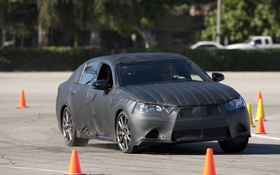2013 Lexus GS: Pumped up and more dynamic
A young Camry tries to keep up after being passed by the new Lexus GS that I’m driving down the sinewy roads of the Azusa Canyon near Pasadena, California. One corner was all it took to convince the Camry that keeping pace with the GS was not such a good idea. Perhaps he was intrigued by the camouflage cover masking the prototype, but the driver quickly remembered what curiosity did to the cat.
The fourth generation of the Lexus GS will be officially unveiled at the Pebble Beach Concours d’Élégance. But I had the chance to drive two pre-production prototypes covered in vinyl cloth sections zipped together to conceal the car’s identity. We got to drive on an autocross course set up in a huge private parking area next to the Azusa Canyon highway. Koji Sato, the lead engineer behind the 2013 Lexus GS upgrades, was in attendance along with Shuichi Ozaki who, according to his business card, is the “meister” of the company’s vehicle performance assessment division. Although both these gentlemen seemed quiet by nature, they were all the more tight-lipped because complete information about this vehicle will only be released at the world premiere. But to whet your appetite, here’s a summary of what I learned during this test drive in which I was allowed to compare the new generation with the current model.
A dynamic Lexus!
The new GS is markedly more dynamic than the current model. Although the two weigh the same (approximately 1,650 kg), the new GS’ chassis is 15% more rigid, with 52% of the total weight in the front and 48% in the back. Both the platform and the geometry of the suspensions were redesigned, resulting in an all-new rear suspension. Launching onto the canyon highway, the GS acted a lot more like a BMW than a Lexus, especially in Sport-S mode. This mode tightens the suspensions while offering a quicker response to the throttle. The automatic gearbox offers quicker shifting, too. When you put the vehicle into manual mode and use the steering-wheel mounted paddles, the transmission automatically increases revs as you downshift (the famous accelerator blip) so that the car keeps its balance as it slows. Overall, the new GS offers much better handling and can hack a little more action, compared to the current model.
One of the two prototypes I was lucky enough to test came equipped with Dynamic Handling and Dynamic Rear Steering, both available as options. This car was especially impressive thanks to noticeably reduced understeering. If sport driving is your thing, I strongly recommend taking these options when the 2013 GS hits the Canadian market next spring. While the vehicle’s dynamics were greatly improved, the steering is still a bit light and over-assisted. But the two Lexus engineers told me that a final decision has yet to be made on the steering calibration. They also clarified that several other tweaks would be made after a series of evaluations.
Stylish? Maybe…
It’s hard to say much about the style of the 2013 GS, since the two I tested were totally camouflaged. But I’m willing to bet that it will look quite a bit like the LF-Gh concept car that Lexus unveiled at the New York Auto Show last April. If it does, it will bear a new front grille and its front and rear lights will partially be made up of LEDs. The interior send a lot more spacious than the current model and the dashboard featured a 30 centimetre screen and a 3D analog clock. The front seats come with adjustable air support for superb lateral support on corners.
The trunk has grown from 12.7 cubic feet (360 litres) to approximately 15.8 cubic feet (447 litres) thanks to the newly designed rear suspension. Both the engine and automatic gearbox were revised, though no details were given to us about that. We’ll also have to wait for additional information about the new hybrid engine set to debut in the model premiering at the 2013 Frankfurt Auto Show next September.











